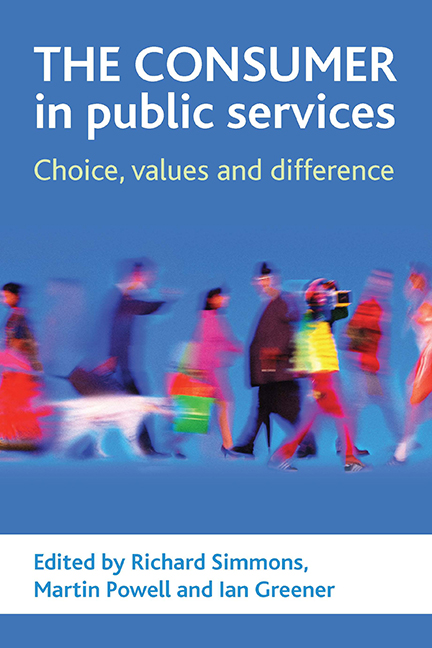Book contents
- Frontmatter
- Contents
- List of figures and tables
- Acknowledgements
- Notes on contributors
- Foreword
- one Introduction: managing the ‘unmanageable consumer’
- two The consumer and New Labour: the consumer as king?
- three Narratives of public service delivery in the UK: comparing central and local government
- four Understanding the ‘differentiated consumer’ in public services
- five Differentiating consumers in professional services: information, empowerment and the emergence of the fragmented consumer
- six The healthcare consumer
- seven The consumer in education
- eight The consumer and social housing
- nine The people’s police? Citizens, consumers and communities
- ten The consumer in social care
- eleven Differentiated consumers? A differentiated view from a service user perspective
- twelve Authoritative consumers or experts by experience? User groups in health and social care
- thirteen The public service consumer as member
- fourteen Conclusion: the consumer in public services
- Index
seven - The consumer in education
Published online by Cambridge University Press: 22 January 2022
- Frontmatter
- Contents
- List of figures and tables
- Acknowledgements
- Notes on contributors
- Foreword
- one Introduction: managing the ‘unmanageable consumer’
- two The consumer and New Labour: the consumer as king?
- three Narratives of public service delivery in the UK: comparing central and local government
- four Understanding the ‘differentiated consumer’ in public services
- five Differentiating consumers in professional services: information, empowerment and the emergence of the fragmented consumer
- six The healthcare consumer
- seven The consumer in education
- eight The consumer and social housing
- nine The people’s police? Citizens, consumers and communities
- ten The consumer in social care
- eleven Differentiated consumers? A differentiated view from a service user perspective
- twelve Authoritative consumers or experts by experience? User groups in health and social care
- thirteen The public service consumer as member
- fourteen Conclusion: the consumer in public services
- Index
Summary
Introduction
The consumer role in education is one that has historically existed prior to legislative reform. Parents have always had choices about ‘which school’ in terms of private or state school, religious or non-religious, and also choices about where they live and, by implication, where their children go to school. It is now almost 30 years since the introduction of legislative reforms promoting additional elements of choice in the UK education service. Following the reforms put in place during the 1980s, parents, pupils and users have been empowered to participate further in the selection of services. In addition to the consumer-oriented reforms, elements of the reform agenda have also stressed the involvement of citizens in education and there are now opportunities for parents and users to have an input into the management and leadership of schools. Using the ‘voice’, ‘choice’ and ‘exit’ framework, the aim of this chapter is to discuss the consumer in education. It is divided into three parts. Part one focuses on the involvement of citizens, consumers and parents in education. In part two, the mechanisms of consumption are reviewed. The use of the market, catchment areas and also the allocation of school places by lottery are each investigated. Part three outlines the different faces of consumerism and citizen participation in education. Conclusions are drawn about the involvement of citizen-consumers in education services.
Citizens, consumers and parents in education
Prior to 1979, the language used in all public services to describe those receiving them was centred around notions of professional autonomy and the dependency of clients (Clarke and Newman, 1997). Words including ‘patients’, ‘parents’, ‘pupils’, ‘prisoners’, ‘tenants’ and ‘clients’ each suggest users who were the recipients of public services. Further, they suggest users who are having services provided to them with little activity or participation on their behalf. Le Grand (2003) argues that these users were considered to be passive. Le Grand (2003, p 6) elaborates further in relation to patients:
Patients were supposed to live up to their appellation and be patient. They were to wait patiently in queues at general practitioners’ surgeries or at outpatient clinics; if they needed further treatment they had to be prepared to wait their turn on hospital waiting lists.
- Type
- Chapter
- Information
- The Consumer in Public ServicesChoice, Values and Difference, pp. 119 - 136Publisher: Bristol University PressPrint publication year: 2009



